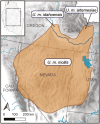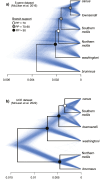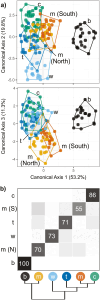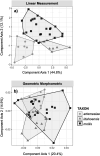Integrative species delimitation reveals an Idaho-endemic ground squirrel, Urocitellus idahoensis (Merriam 1913)
- PMID: 40144356
- PMCID: PMC11933283
- DOI: 10.1093/jmammal/gyae135
Integrative species delimitation reveals an Idaho-endemic ground squirrel, Urocitellus idahoensis (Merriam 1913)
Abstract
The "small-eared" species group of Urocitellus ground squirrels (Sciuridae: Xerinae: Marmotini) is endemic to the Great Basin, United States, and surrounding cold desert ecosystems. Most specific and subspecific lineages in this group occupy narrow geographic ranges, and some are of significant conservation concern; despite this, current taxonomy remains largely based on karyotypic or subtle pelage and morphological characteristics. Here, we leverage 2 multilocus DNA sequence data sets and apply formal species delimitation tests alongside morphometric comparisons to demonstrate that the most widespread small-eared species (U. mollis Kennicott, 1863 sensu lato; Piute Ground Squirrel) is comprised of 2 nonsister and deeply divergent lineages. The 2 lineages are geographically separated by the east-west flowing Snake River in southern Idaho, with no sites of sympatry currently known. Based on robust support across the nuclear genome, we elevate populations previously attributed to U. mollis from north of the Snake River to species status under the name Urocitellus idahoensis (Merriam 1913) and propose the common name "Snake River Plains Ground Squirrel" for this taxon. We delimit 2 subspecies within U. idahoensis; U. i. idahoensis (Merriam 1913) in western Idaho and U. i. artemesiae (Merriam 1913) in eastern Idaho. Urocitellus idahoensis is endemic to Idaho and has a maximal range area of roughly 29,700 km2 spanning 22 counties but occurs discontinuously across this area. Our work substantially expands knowledge of ground squirrel diversity in the northern Great Basin and Columbia Plateau and highlights the difficulty in delimiting aridland mammals whose morphological attributes are highly conserved.
Keywords: Columbia Plateau; Great Basin; Marmotini; Snake River; UCEs; geometric morphometrics; mitonuclear discordance.
© The Author(s) 2024. Published by Oxford University Press on behalf of the American Society of Mammalogists.
Conflict of interest statement
None declared.
Figures





Similar articles
-
Lead exposure of a fossorial rodent varies with the use of ammunition across the landscape.Sci Total Environ. 2024 Dec 1;954:176406. doi: 10.1016/j.scitotenv.2024.176406. Epub 2024 Sep 19. Sci Total Environ. 2024. PMID: 39304143
-
Imperiled wanderlust lichens in steppe habitats of western North America comprise geographically structured mycobiont lineages and a reversal to sexual reproduction within this asexual clade.Mol Phylogenet Evol. 2024 Dec;201:108212. doi: 10.1016/j.ympev.2024.108212. Epub 2024 Oct 9. Mol Phylogenet Evol. 2024. PMID: 39384122
-
Complementary Network-Based Approaches for Exploring Genetic Structure and Functional Connectivity in Two Vulnerable, Endemic Ground Squirrels.Front Genet. 2017 Jun 14;8:81. doi: 10.3389/fgene.2017.00081. eCollection 2017. Front Genet. 2017. PMID: 28659969 Free PMC article.
-
Impacts of late Quaternary environmental change on the long-tailed ground squirrel (Urocitellus undulatus) in Mongolia.Zool Res. 2018 Sep 18;39(5):364-372. doi: 10.24272/j.issn.2095-8137.2018.042. Epub 2018 Mar 8. Zool Res. 2018. PMID: 29551757 Free PMC article.
-
Complete mitochondrial genomes of Callospermophilus lateralis and Urocitellus richardsonii (Rodentia: Sciuridae).Mitochondrial DNA B Resour. 2016 Jun 20;1(1):359-360. doi: 10.1080/23802359.2016.1168716. Mitochondrial DNA B Resour. 2016. PMID: 33473483 Free PMC article.
References
-
- Aberg MC. 2023. A coupled human and natural systems approach to studying recreation on public lands [doctoral dissertation]. Boise (ID, USA): Boise State University. https://www.proquest.com/docview/2835521427
-
- Adams DC, Collyer ML, Kaliontzopoulou A, Baken EK. 2022. Geomorph: software for geometric morphometric analyses. Version 4.0.4. [Computer software]. https://cran.r-project.org/package=geomorph
-
- Allen JA. 1874. On geographical variation in color among North American squirrels; with a list of the species and varieties of the American Sciuridae occurring north of Mexico. Proceedings of the Boston Society of Natural History 16(1873-1874):276–294. https://www.biodiversitylibrary.org/item/130707
-
- Arbogast BS, Schumacher KI, Kerhoulas NJ, Bidlack AL, Cook JA, Kenagy GJ. 2017. Genetic data reveal a cryptic species of New World flying squirrel: Glaucomys oregonensis. Journal of Mammalogy 98(4):1027–1041. https://doi.org/10.1093/jmammal/gyx055 - DOI
-
- Augustine DJ, Smith JE, Davidson AD, Stapp P. 2023. Burrowing rodents. In: McNew LB, Dahlgren DK, Beck JL, editors. Rangeland wildlife ecology and conservation. Cham (Switzerland): SpringerLink; p.505–548.
LinkOut - more resources
Full Text Sources

